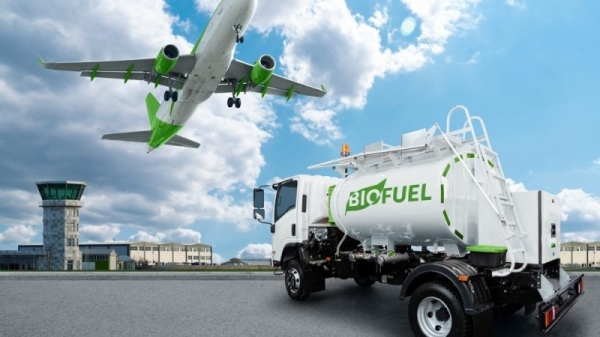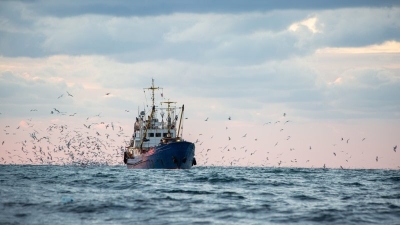Can citizens trust sustainable aviation fuel?

The market for low-carbon fuel for aeroplanes is still nascent, but it’s growing. As airlines try to sell themselves as greener than their competitor, how can claims about their fuels be verified?
Out of all the sectors with large climate change impacts, aviation has remained one of the toughest nuts to crack. While trains, cars and trucks can be converted to using electricity from biofuels relatively easily, planes cannot. Their mammoth size means that so far, barring a few test flights and pilot projects, developing a commercially viable Sustainable Aviation Fuel (SAF) that can power a jet engine across an ocean has proven difficult.
And yet, aviation is one of the public’s top concerns about climate change because of the outsize impacts a flight’s emissions have due to its high altitude.
Corporations that have recently started quantifying their emissions to set greenhouse gas emissions reduction targets have found that aviation emissions from business travel make up a significant amount, and they are eager to get that number down.
In general, passengers want to feel less guilt about flying. And airlines are eager to be the ones who can offer them a lower-emissions option in a cost-effective way. Studies have shown that while passengers want their flights to produce less emissions, they’re not willing to pay significantly more for it.
So the SAF market, while still nascent at this stage, is receiving a lot of research and development funding, and is growing rapidly. Last year the European Union adopted the ReFuelEU Aviation Regulation which will require EU airports and fuel suppliers to supply SAF as at least 2% of aviation fuels by 2025, 6% by 2030, 20% by 2035, 34% by 2040, 42% by 2045, and 70% by 2050.
A dedicated sub-target for synthetic fuels derived from green hydrogen will also come into force from 2030. Starting at 1.2%, this will be scaled up to 5% by 2035, reaching 35% by 2050.
Tracing biofuel sustainability
The new EU law, along with similar national legislation being passed around the world, is expected to provoke a big boost in the SAF market. But at the same time, this is a complicated area and regulators want to make sure that airlines and fuel suppliers aren’t exaggerating sustainability claims about these fuels. That means, alongside the development of the fuels themselves, certification schemes are also being developed.
One of those schemes is the International Sustainability and Carbon Certification (ISCC), an independent multi-stakeholder initiative which has been certifying products and services as sustainable and climate-friendly around the world since 2006.
“If so much emphasis is placed on SAF as the silver bullet for greening aviation, then the ‘S’ in SAF really needs to live up to the promise,” says Thomas Bock, Senior System Manager for Aviation at ISCC. For SAF produced from biofuels to be deemed sustainable, he says, feedstock production must not take place on valuable land, such as those with high carbon stock and high biodiversity.
“Both feedstock and fuel production must avoid any detrimental effects on aspects such as water quality and availability, soil health, air quality, conservation areas, food security, and human and labour rights, among others,” he explains.
Methodologies have been developed within the framework of the EU Renewable Energy Directive and the CORSIA program of the International Civil Aviation Organisation (ICAO) to calculate the greenhouse gas emissions resulting from the whole SAF supply chain, from crop production to fuel burning.
To ensure this, traceability mechanisms need to be set up along the whole supply chain and they must be monitored, so that regulators, airlines and third parties can be confident that the SAF they are buying has the environmental attributes it claims to come with.
It would be difficult for all those entities to do this on their own, and that is why they traditionally rely on third-party certification bodies to do so.
Monitoring hydrogen
Biofuel-derived SAF isn’t the only possibility being pursued. Companies are also developing so-called “eSAF” – hydrogen or molecules such as e-ammonia, and e-methane that are derived from hydrogen. The umbrella term for all of these gaseous and liquid renewable fuels that do not rely on biomass is Renewable Fuels of Non-Biological Origin (RFNBOs). The main technology used to produce them is electrolysis powered by renewable electricity to produce hydrogen.
Bock says ISCC has recently noticed an increased market interest from companies worldwide in these very new hydrogen and hydrogen-derived fuels, and they are developing equally robust tracing systems for these. “ISCC has developed a certification approach for both RFNBOs and [biofuel SAF] and tested it in several pilot certifications,” he says, noting that they submitted this certification approach to the European Commission last year for recognition.
The approval process is still ongoing. These certification schemes are being built up based on pilot projects via ISCC’s sister company Meo Carbon Solutions, and its voluntary scheme ISCC Plus.
“So far more than 150 companies have received certifications from ISCC for their SAF activities under the different ISCC certification schemes,” he says. “This includes almost all currently active SAF production plants, different feedstock producers – mostly for waste and residue feedstocks – as well as intermediate processing units and traders.”
Watching the market
The reason these are still pilot projects is that there are currently few active SAF production plants in operation. But SAF production capacity is rapidly increasing, says Bock. “To date, commercial viability has only been demonstrated for one SAF production pathway, the HEFA pathway, based mainly on waste and oils as feedstock,” he says.
“Almost all SAF plants currently in operation use the HEFA pathway. This SAF pathway will provide the vast majority of SAF volumes until 2030.” But the feedstocks for this pathway, such as animal fats, are limited – and also in demand from other sectors. So other pathways need to be commercialised to use other feedstocks such as municipal solid waste and agricultural and forestry residues, he says.
So far, the SAF made from waste and residue feedstocks, especially UCO (used cooking oil) and animal fats, is proving to be the most commercially viable. “SAF made from food and feed crops is also a viable option, particularly in regions outside the EU, which do not take such a critical instance towards biofuels from food and feed crops as the EU does.”
For eSAF, Bock believes that this won’t play a large role until after 2030 because the technology is not yet mature. Electric flights or those powered by hydrogen are “unlikely to play a significant role for decades to come, with the exception of short-haul flights,” he says.
[By Dave Keating I Edited by Brian Maguire | Euractiv’s Advocacy Lab ]
Read more with Euractiv



